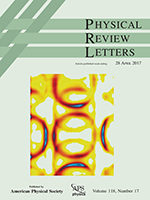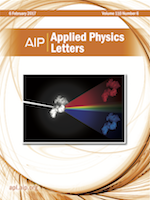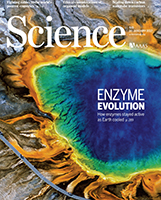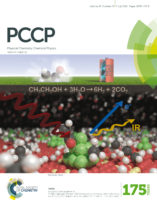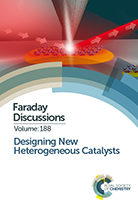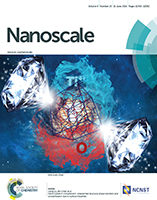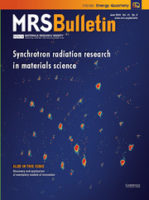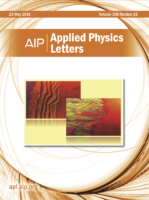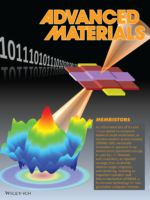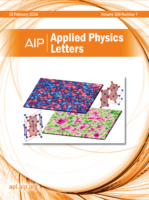Angle-resolved photoemission spectroscopy was used to measure the electronic structure of LiCu2O2, a mixed-valence cuprate where planes of Cu(I) (3d10) ions are sandwiched between layers containing one-dimensional edge-sharing Cu(II) (3d9) chains. Read more »
Journal Covers
Near-Edge X-Ray Refraction Fine Structure Microscopy
Soft x-ray ptychography was used to measure the absorption and refraction of x-rays through pristine reference materials as a basis for decomposing spatially resolved spectra from a heterogeneous sample, thereby quantifying the composition at high resolution. The novel method provided a nearly five-fold improvement in spatial resolution on resonance. Read more »
Evolutionary drivers of thermoadaptation in enzyme catalysis
With early life likely to have existed in a hot environment, enzymes had to cope with an inherent drop in catalytic speed caused by lowered temperature. Here, researchers characterize the molecular mechanisms underlying thermoadaptation of enzyme catalysis in adenylate kinase using ancestral sequence reconstruction spanning 3 billion years of evolution. Read more »
Ambient Pressure XPS and IRRAS Investigation of Ethanol Steam Reforming on Nickel–Ceria Catalysts
Ambient-pressure x-ray photoelectron spectroscopy (AP-XPS) and infrared reflection absorption spectroscopy (AP-IRRAS) have been used to elucidate the active sites and mechanistic steps associated with the ethanol steam reforming reaction (ESR) over Ni–CeO2(111) model catalysts. Read more »
High spatial resolution mapping of chemically-active self-assembled N-heterocyclic carbenes on Pt nanoparticles
Many functional materials (e.g. catalysts) critically depend on the spatial distribution of surface active sites. However, most spectroscopic measurements are ensemble-based, where reactivity is averaged over millions of nanoparticles. Here, carbene attached to nanoparticle surfaces serves a model system for studying catalytic reactions on single nanoparticles. Read more »
Nanocrystals in compression: unexpected structural phase transition and amorphization due to surface impurities
We report an unprecedented surface doping-driven anomaly in the compression behaviors of nanocrystals. The results suggest that the physical properties of the interior of nanocrystals can be controlled by the surface, providing an unconventional and new degree of freedom in search for nanocrystals with novel tunable properties that can trigger applications in multiple areas of industry and provoke more related basic science research. Read more »
Quantitative Microstructural Imaging by Scanning Laue X-ray Micro- and Nanodiffraction
Synchrotron Laue x-ray microdiffraction turns 20 this year. The June 2016 issue of MRS Bulletin is dedicated to synchrotron radiation research in materials science and features a review article on the current capabilities, latest technical developments, and emerging applications of Laue x-ray micro- and nanodiffraction co-authored by ALS beamline scientist Nobumichi Tamura. The cover image shows a Laue x-ray microdiffraction pattern from a sea urchin tooth taken on Beamline 12.3.2. Read more »
In-situ Characterization of Highly Reversible Phase Transformation by Synchrotron X-ray Laue Microdiffraction
In situ measurement of the orientation matrices for the austenite and martensite phases of the alloy Cu25Au30Zn45 across the interface was performed by synchrotron x-ray Laue microdiffraction at the ALS. Together with theoretical calculations, researchers verified directly and quantitatively the factors that contribute to the alloy’s elastically compatible interface, which ultimately leads to the ultralow fatigue property of phase transformation in martensitic materials. The approach can be generalized to characterize the evolution of microstructure when the transport properties are sensitive to the structural compatibility at the heterogenous phase boundaries. Read more »
Direct Observation of Localized Radial Oxygen Migration in Functioning Tantalum Oxide Memristors
As information bits of 0s and 1s are stored in crosspoint tantalum oxide memristors, or resistive random access memory (RRAM) cells, nanoscale-resolution in operando x-ray transmission spectromicroscopy is used to directly observe oxygen migration and clustering, revealing an important operation and failure mechanism of RRAM, a frontrunner technology for next-generation computer memory. Read more »
The Phase Transition in VO2 Probed Using X-ray, Visible and Infrared Radiations
The nearly simultaneous Mott (electronic) and Peierls (structural) transitions in vanadium dioxide are of significant scientific interest and have tremendous technological promise in computing, memory, optics, and micromechanics. The cover features nanoscale-resolution maps of the Mott and Peierls transitions imaged simultaneously by Kumar et al. using state-of-the-art in situ STXM at the ALS. Read more »
